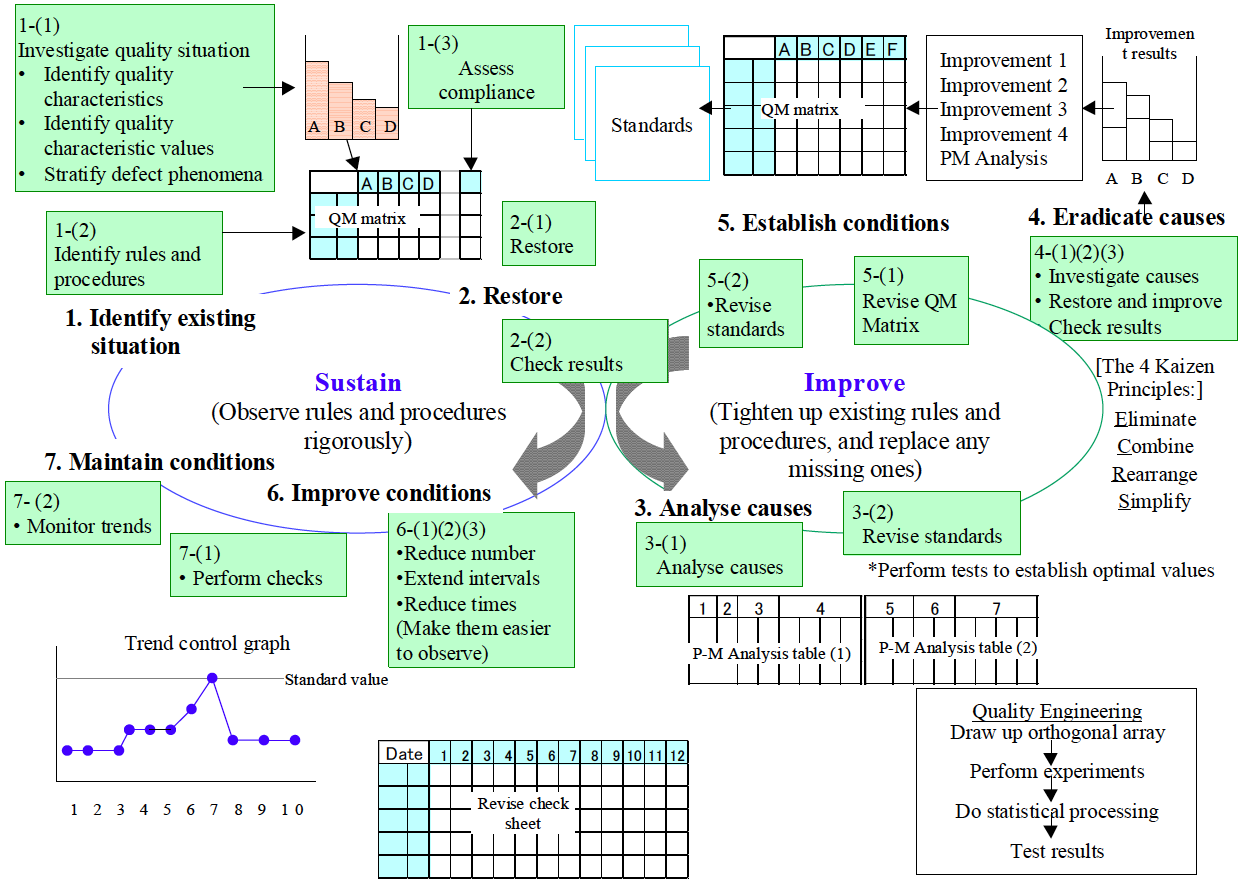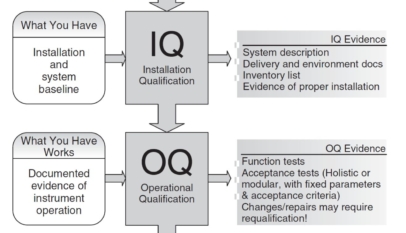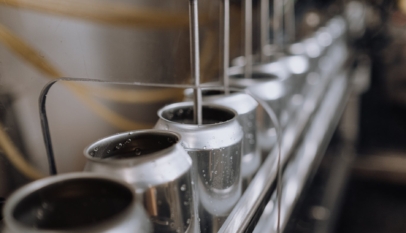Many different companies have adopted the Figure-of-Eight method over recent years. It is based on the seven steps discussed in this post, distributed around two interconnecting loops (a “sustainment” loop on the left and an “improvement” loop on the right), and it seeks to improve the level of both these activities in a never-ending upward cycle. Figure “Overview of the Figure-of-Eight Method for Quality Maintenance” illustrates the basic concepts and the steps to be followed.
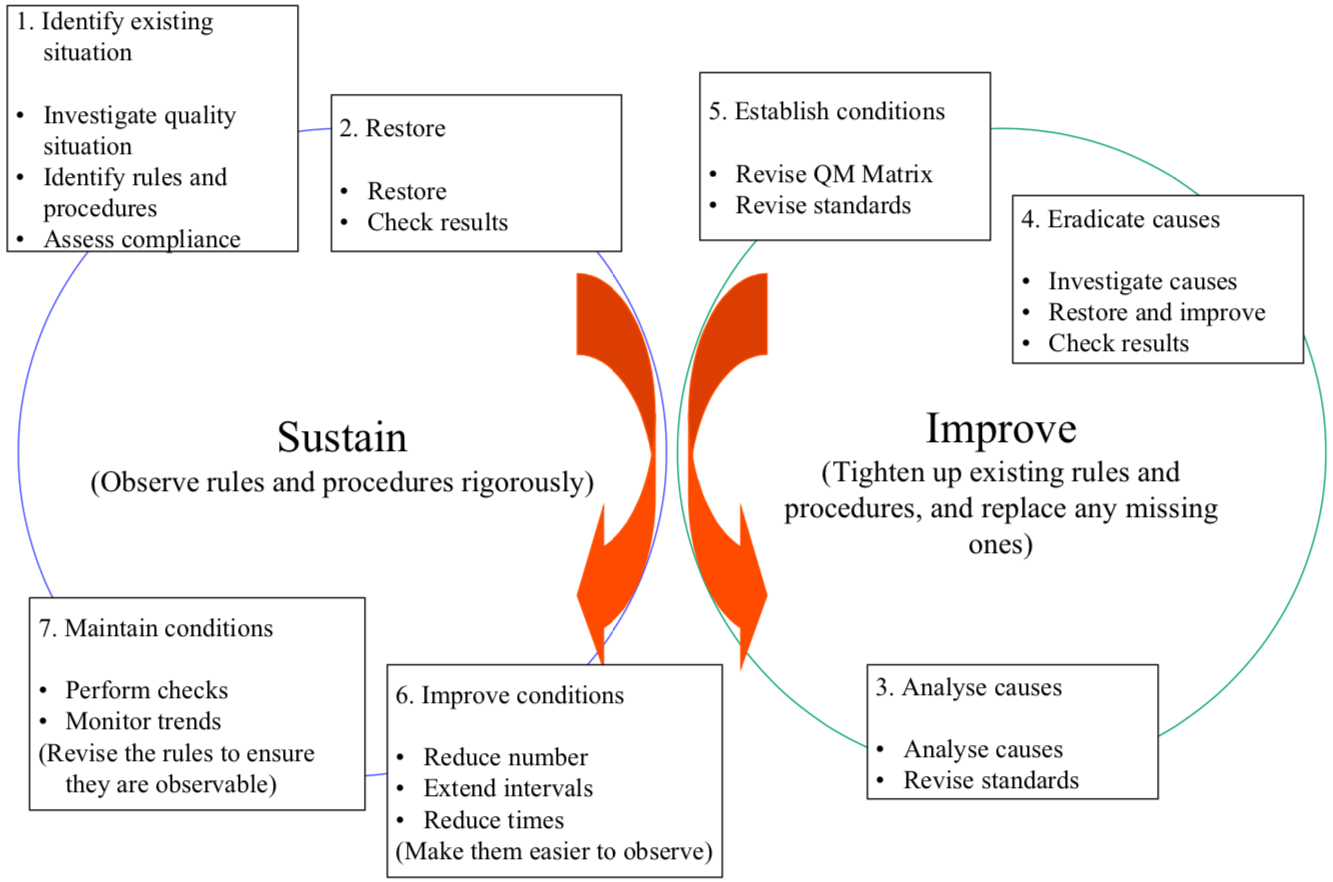
Only by fully understanding the aim of each step can we create a reliable, robust system for building quality into the product. The steps and objectives are described below.
(1) Step 1: Identify Existing Situation
In the Figure-of-Eight method, ‘identify existing situation’ has a slightly different meaning to the usual. The difference is that, as well as investigating the quality situation and identifying current rules and procedures, and it is also necessary to assess how strictly they are being complied with.
1 Investigate quality situation
The current quality situation is identified by finding out what quality characteristics must be maintained in each work area or process, together with their standard values.
2 Identify rules and procedures
Here, we examine QC process charts, work standards, processing condition tables, etc., to find out all the rules and procedures currently seen as necessary in each work area or process for building quality into the product.
3 Assess compliance
Next, we examine the extent to which these rules and procedures are being observed.
By carrying out these three sub-steps, we can summarise the existing quality situation in the form of a QM Matrix (or Quality Assurance Level Evaluation Table) for each work area.
(2) Step 2: Restore
Any deficiencies discovered in Step 1 are now addressed to restore the situation to what it should be. The results are then checked and evaluated to indicate what to do next.
1 Restore to current optimal state
If we find in Step 1 that any of the existing rules or procedures are not being observed, we must ensure that they are to restore the situation to what it should currently be.
2 Check results
Next, we check the results obtained by restoring the current optimal state.
The critical point in Step 2 is to determine what to do next by checking the results (see Figure “Actions Taken After Checking Results”). The action required will be one of the following three types:
Type I: If satisfactory results are not achieved by restoring the current situation, we move on to Step 3 in the Improvement loop, where we examine the conditions and reassess the traditional values to find out where our current rules and procedures are incomplete or incomplete insufficiently rigorous.
Type II: If the results are good, we advance to Step 6, revising our sustainment systems.
Type III: If the results are better than before but still do not clear our targets, then moving to Step 6 to maintain the results achieved so far, we also advance to Step 3 to rise to our targeted level.
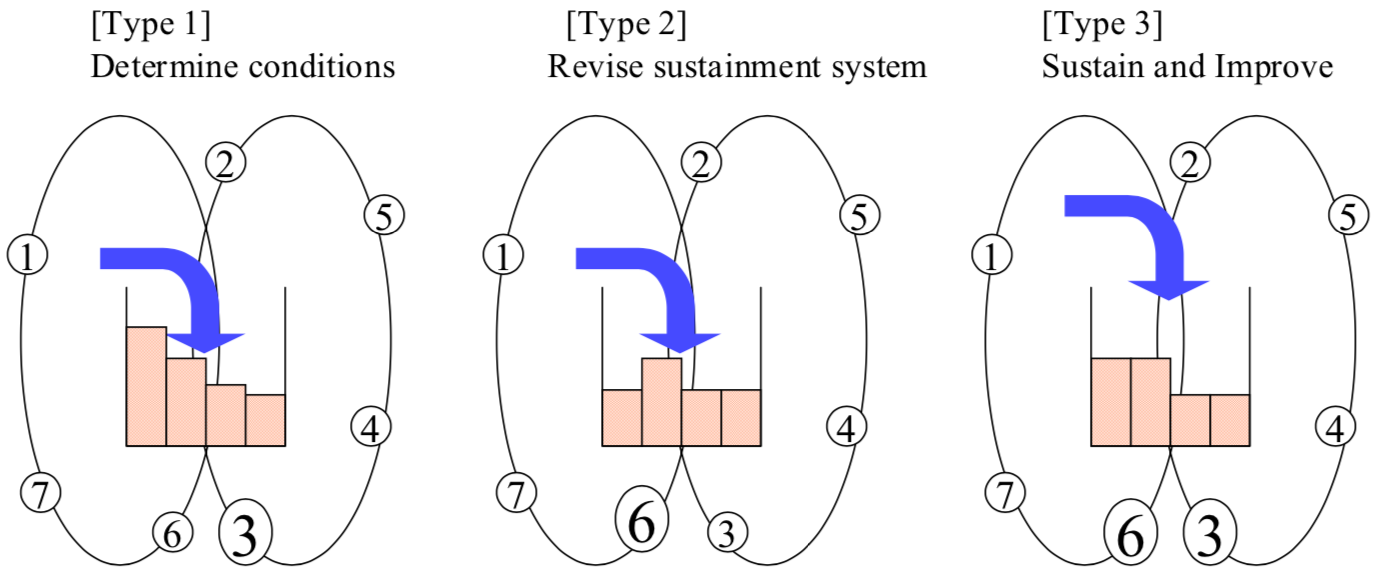
(3) Step 3: Analyze Causes
If we have still not got the results, we are looking for, even after ensuring that all the current rules and procedures are being observed, either the rules and procedures are incomplete, or the standards are too lenient. Therefore, we must analyze the causes of poor quality to determine exactly what standards we do need.
Analyze causes
When analyzing causes, it is essential to get back to basics and clarify the exact phenomena that occur, expressing these phenomena as deviations in physical quantities, based on an accurate understanding of the principles and parameters involved. We must then identify the possible causes of these deviations by taking account of the processing mechanisms and the functions and structure of the equipment used. P-M Analysis is a potent tool for doing this.
Revise standard values
We need to check how ‘robust’ they are when revising the standard values. Many firms have recently introduced Quality Engineering (Taguchi Methods) to help them.
(4) Step 4: Eradicate Causes
Here, we carry out three sub-steps based on the analysis of causes carried out in Step 3.
Investigate causes
Using Quality Engineering, optimal conditions must be determined for all the possible causes of poor quality identified by P-M Analysis. In other words, we must identify what necessary conditions were missing from the existing system and which of the current standards were too lenient.
Restore and improve
Next, we add any missing conditions, revise any insufficiently robust standards, and improve where necessary. It is vital to devise improvements that are easy to maintain to facilitate the sustainment activities carried out later on.
Check results
We then devise quick methods for evaluating the results of our improvements. When we have confirmed that the results are satisfactory, we can move on to the next step (Step 5).
(5) Step 5: Establish Conditions
If we have obtained satisfactory results, we establish exactly what is required to maintain this state. The key to this is revising the QM matrix.
Revise QM matrix
First of all, we take the provisional QM matrix created in Step 1 and amend it in light of all the items highlighted by our P-M Analysis and Quality Engineering studies. This involves revising standard values, adding or removing certain things, altering methods, and so on.
Revise standards
It is essential that each revision made to a standard is referenced clearly to a technical report, improvement report, or another such document so that everyone understands the reasons for the correction.
(6) Step 6: Improve Conditions
Having resolved the defect phenomena by restoring the situation in Step 2, it is vital to think hard about why the conditions were not observed and how we can adapt our sustainment methods to ensure that they are. The ideal situation may be hard to maintain, or it may be hard to notice when conditions have slipped.
When we look at what happens on the factory floor, it is more usual that workers cannot observe the conditions, rather than that they do not want to observe them. So, to achieve a reliable sustainment system, it is essential to make the conditions easy to comply with. To do this, we must develop ideas for reducing the number of different actions required and making it possible to perform them quicker and less often.
(7) Step 7: Maintain Conditions
One possible reason for not sustaining the required conditions is a failure to notice when this happens. This requires us to do two things:
Revise checksheets
Suppose we want to make sure that what ought to be done is being done, and done reliably, by the people who ought to do it. In that case, it is crucial to establish a checking system to confirm that each worker and manager is fulfilling their responsibilities.
Monitor trends
Any conditions that tend to deteriorate should be extracted from the QM matrix and monitored on charts to predict the occurrence of defects.
Having dealt with the first problem by completing one cycle of the Figure-of-Eight, we now need to move on to the next issue and make a second trip, starting again from Step 1, while sustaining the solution we have installed for the first problem. By continually repeating this cycle of sustainment and improvement, we can progressively improve our workplaces’ capacity to build in quality, which is, in fact, the aim of the Figure-of-Eight method for Quality Maintenance.
Figure “The Figure-of-Eight Method for Quality Maintenance” shows a general view of how Quality Maintenance can be developed using the Figure-of-Eight method.
